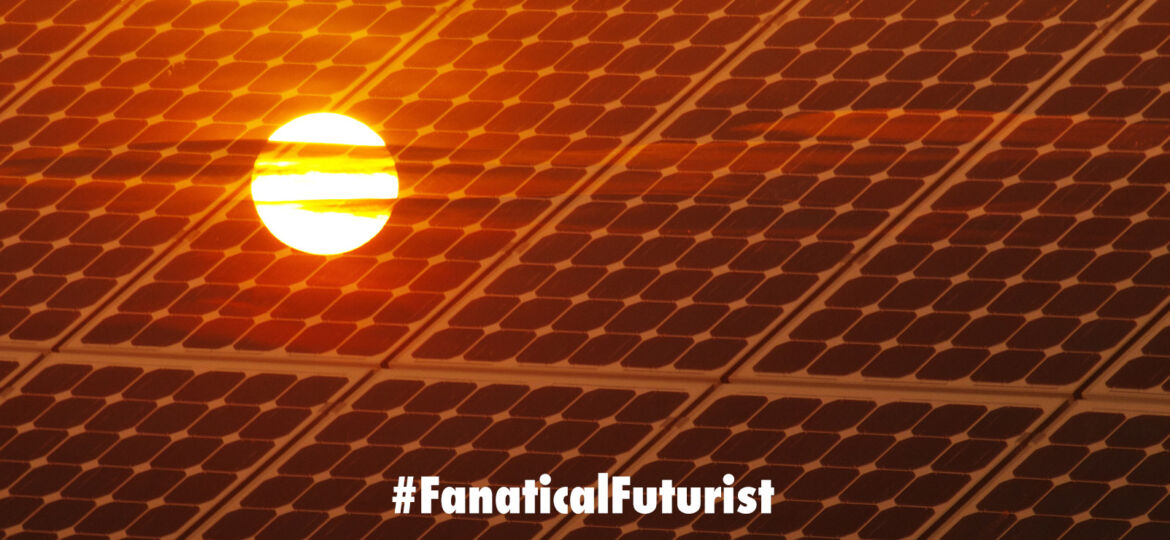
WHY THIS MATTERS IN BRIEF
Solar energy and renewable energy give the world a pathway to green, sustainable energy production, and the solar efficiency record just got obliterated.
 Interested in the Exponential Future? Connect, download a free E-Book, watch a keynote, or browse my blog.
Interested in the Exponential Future? Connect, download a free E-Book, watch a keynote, or browse my blog.
I’ve been pointing out for a couple of years now that we have a pathway to creating solar panels that absolutely smash todays records for efficiency and drive fossil fuels back into the dinosaur age, and up until now advances in solar efficiency have been the result of the development of new perscovite panels with 32 percent efficiency, bacterial solar panels with up to 50 percent, and carbon nanotube panels with up to 80 percent efficiency. All of which is for starters. Today, we also have solar panels that can work at night, and harvest energy from rain and snow, even in cloudy weather, and we also have a pathway to creating spray on solar panels – the precursors of which are already being used to create the first batteryless solar powered cars.
Now, in another major advance for the industry another kind of solar technology developed by a team at the US Department of Energy and the National Renewable Energy Laboratory has just set a world record for the most efficient generation of energy by a solar cell. By stacking six different photoactive layers, the record-setting multi-junction cell has reached nearly 50 percent efficiency in the lab and nearly 40 percent in “single sun” real-life conditions. And it’s a staggering feat.
There’s a bit of jargon to unpack before we can really understand what a big deal this is. First, a multi-junction cell is just a solar collector cell that uses more than one “junction,” or layer, of solar technology. Because sunlight covers such a wide range of wavelengths, different kinds of receivers are able to pick up different wavelengths of light in order to cover more of the total available spectrum.
Individual types of solar might have efficiency of, say, 15 percent -meaning 85 percent of sunlight is just reflected off like any other surface, but 8 percent is absorbed and collected as energy, but by stacking the technologies from six different solar cells, solar researchers can ratchet up that efficiency multiple times over.
The more efficient an overall technology is, the more we can shrink panel size while keeping the same energy production. That can mean panels that are: cheaper for consumers outfitting their homes, smaller, able to be shaped around tiny or complicated surfaces, and able to power a lot more stuff. Imagine if one gallon of paint suddenly covered five times more area, or if one meal could feed five people.
In total, there are 140 layers of the six different solar collector materials. Even so, the entire collecting surface is one-third the thickness of a human hair. The research team used different semiconductors and carefully arranged them to maximize usable surface area through all 140 layers. “Further reduction of the series resistance within this structure could realistically enable efficiencies over 50 [percent],” the researchers say.
The semiconductors are of a type called III-V, which is a family of alloys made by combining elements from periodic table group III with those from group V. In fact, the elements from both III and V groups are primarily known in alloy form.
“Because of the unique properties of the compound III-V semiconductors, they have been the source of a rich world of science, technology and applications,” Sandia National Laboratory said in a 2004 report. “This world has, on the science side, led to 7 Nobel Prizes in Physics; and, on the applications side, led to a roughly $12B global chip market in 2001, projected to become $31B in 2006.”
It sounds like III-V’s next Nobel trick could be for revolutionizing solar panel efficiency, with a world record that translates directly into more renewable energy and more energy density during uncertain global times.
















